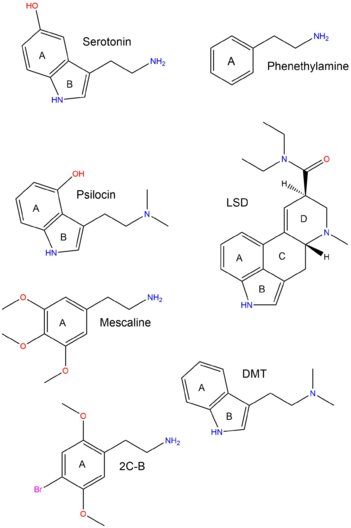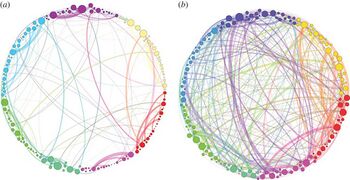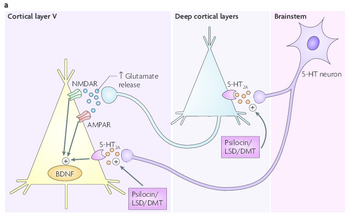Serotonergic psychedelic: Difference between revisions
>Unity thoughts on sizing? and making the thumbnail info for 3rd pic more expandable? |
>Unity Grammatics |
||
| Line 7: | Line 7: | ||
==Method of action== | ==Method of action== | ||
[[File:Psilocybin neural connections.jpg|350px|thumbnail|right|The diagram above demonstrates the neural connections associated with sobriety in comparison to being under the influence of psilocybin as demonstrated through the use of MRI scans.<ref>What your brain looks like on magic mushrooms | http://www.telegraph.co.uk/news/science/science-news/11207979/What-your-brain-looks-like-on-magic-mushrooms.html</ref>]] | [[File:Psilocybin neural connections.jpg|350px|thumbnail|right|The diagram above demonstrates the neural connections associated with sobriety in comparison to being under the influence of psilocybin as demonstrated through the use of MRI scans.<ref>What your brain looks like on magic mushrooms | http://www.telegraph.co.uk/news/science/science-news/11207979/What-your-brain-looks-like-on-magic-mushrooms.html</ref>]] | ||
[[File: | [[File:NeuroPsychDiagram.png|thumbnail|350px|right|Figure 1 - Activation of the prefrontal network and glutamate release by psychedelics. The figure shows a model in which hallucinogens, such as psilocin, lysergic acid diethylamide (LSD) and dimethyltryptamine (DMT), increase extracellular glutamate levels in the prefrontal cortex through stimulation of postsynaptic serotonin (5-hydroxytryptamine) 2A (5-HT 2A ) receptors that are located on large glutamatergic pyramidal cells in deep cortical layers (V and VI) projecting to layer V pyramidal neurons. This glutamate release leads to an activation of AMPA (α-amino-3-hydroxy-5-methyl-4- isoxazole propionic acid) and NMDA (N-methyl-d-aspartate) receptors on cortical pyramidal neurons. in addition, hallucinogens directly activate 5-HT2A receptors located on cortical pyramidal neurons. This activation is thought to ultimately lead to increased expression of brain-derived neurotrophic factor (BDNF).<ref>Vollenweider, F. X., & Kometer, M. (2010). The Neurobiology of Psychedelic Drugs: Implications for the Treatment of Mood Disorders. Nature Publishing Group, 11(9), 642–651. https://doi.org/10.1038/nrn2884</ref>]] | ||
{|style="margin: 0 auto;" | {|style="margin: 0 auto;" | ||
[[File:Lsd brain scan.jpg|thumbnail|350px|right|This image shows how, with eyes-closed, much more of the brain contributes to the visual experience under LSD (right image) than under placebo (left image). The magnitude of this effect correlates with participants’ reports of complex, dreamlike visions.<ref>LSD's impact on the brain revealed in groundbreaking images | https://www.theguardian.com/science/2016/apr/11/lsd-impact-brain-revealed-groundbreaking-images</ref>]] | [[File:Lsd brain scan.jpg|thumbnail|350px|right|This image shows how, with eyes-closed, much more of the brain contributes to the visual experience under LSD (right image) than under placebo (left image). The magnitude of this effect correlates with participants’ reports of complex, dreamlike visions.<ref>LSD's impact on the brain revealed in groundbreaking images | https://www.theguardian.com/science/2016/apr/11/lsd-impact-brain-revealed-groundbreaking-images</ref>]] | ||
Revision as of 01:33, 9 April 2017
This page has not been fully approved by the PsychonautWiki administrators. It may contain incorrect information, particularly with respect to dosage, duration, subjective effects, toxicity and other risks. It may also not meet PW style and grammar standards. |

Serotonergic psychedelics (also known as serotonergic hallucinogens) are a class of hallucinogenic drugs with a method of action strongly tied to the neurotransmitter serotonin. Serotonin (often referred to as 5-HT, which is short for its full chemical name 5-hydroxytryptamine) is a naturally occurring neurotransmitter which is tied to positive mood, certain involuntary muscle control, and countless other functions, many of which are not yet fully understood.
Method of action



While the method of action of serotonergic psychedelics is not fully understood, serotonergic psychedelics are known to show affinities for various 5-HT receptors in different ways and levels, and may be classified by their activity at different 5-HT sub-sites, such as 5-HT1A, 5-HT1B, 5-HT2A, etc.
Many serotonergic psychedelics, such as the family of tryptamines, have very strong structural similarities to serotonin itself, which partially explains the affinity for certain 5-HT sites. It is almost unanimously agreed that most serotonergic psychedelics produce their effect by acting as strong partial agonists at the 5-HT2A receptors.
The cortico-striato-thalamo-cortical loops[4] ("CSTC-loops") seem to be central to the function of psychedelics, which are also regulated by the serotonergic system. These control loops connect brain areas like the frontal lobe, the striatum and the thalamus; they aggregate, process and forward internal and external information.
The disruption of the neurotransmitter balance causes these control loops to collapse overwhelmed, leading to the flooding of the frontal lobe with neuronal excitatory glutamate; internal and external stimuli as well as all kinds of non-conscious contents can freely move up to the cerebral cortex and appear as visions in consciousness.[5][6] Furthermore, there is an over-activation of the locus coerlueus and thereby widespread norepinephrine secretion, causing a state of spiritual transcendence and sometimes even intense spiritual experiences.
Worth noting is that selective serotonin reuptake inhibitors (a class of antidepressants including paxil, prozac, and zoloft) can increase the dosage required for hallucinogenic effects of serotonergic psychedelics in some people based on anecdotal reports. Some users, however, have found this to be entirely untrue for them, so users who are using daily antidepressants should, at first, only attempt a common dosage.
Examples
Specific compounds
|
See also
References
- ↑ What your brain looks like on magic mushrooms | http://www.telegraph.co.uk/news/science/science-news/11207979/What-your-brain-looks-like-on-magic-mushrooms.html
- ↑ Vollenweider, F. X., & Kometer, M. (2010). The Neurobiology of Psychedelic Drugs: Implications for the Treatment of Mood Disorders. Nature Publishing Group, 11(9), 642–651. https://doi.org/10.1038/nrn2884
- ↑ LSD's impact on the brain revealed in groundbreaking images | https://www.theguardian.com/science/2016/apr/11/lsd-impact-brain-revealed-groundbreaking-images
- ↑ Taylor, S. B., Lewis, C. R., & Olive, M. F. (2013). The neurocircuitry of illicit psychostimulant addiction: acute and chronic effects in humans. Substance Abuse and Rehabilitation, 4, 29–43. https://doi.org/10.2147/SAR.S39684; [..] The overall output of the basal ganglia is predominantly via the thalamus, which then projects back to the PFC to form cortico-striatal-thalamo-cortical (CSTC) loops. [..]
- ↑ Vollenweider, F. X. (2001). Brain mechanisms of hallucinogens and entactogens. Dialogues in Clinical Neuroscience, 3(4), 265–79. Retrieved from http://www.pubmedcentral.nih.gov/articlerender.fcgi?artid=3181663&tool=pmcentrez&rendertype=abstract
- ↑ Edelrausch im Labor – Neuro Culture Lab (German)

